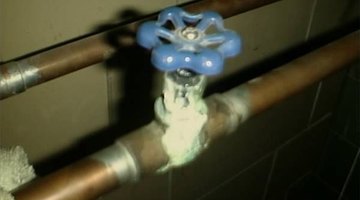How to Replace Water Heater Supply Lines
Replace water heater supply lines if they corrode or begin to spring a pressurized water leak. The flexible copper lines and connector nuts are not as corrosive as the other metals used in water heater production, yet they can be damaged by contact or during repairs and maintenance on water heaters.

Hardware and plumbing supply stores stock replacement lines at reasonable prices, and it doesn't take a plumber to do this repair.
Things You Will Need
- Tape measure
- Pipe wrench or adjustable slip-slot pliers
- Replacement supply lines- same length as current lines
- Rubber gaskets
Tip
Check the other parts of your water heater for leaks and corrosion. If the supply lines are compromised, the water heater may hold similar damage in other areas. The water heater should be replaced if the tank itself is leaking.
Warning
Avoid hazards associated with working on water heaters. Mop up any puddles from leaking lines and move with caution if the unit is in a confined space.
-
Identify the cold water supply line. There should be a "C" or "Cold" embossed in the water heater where the cold water supply line attaches. There will also be a crank knob, similar to the valve on an outdoor hose, either on the wall or along the copper tubing that the other end of the cold line attaches to. That's the cold water supply valve.
-
Locate the pressure release valve. This is a silver 2-inch lever on the pressure release line which should be clearly marked. It may be on the top of the water heater or on the front, just a few inches down from the top. The copper pressure release line is not in consideration for replacement.
-
Find the hot water output line. That's the last copper line which should have an "H" or the word "Hot" on the water heater next to its connection. There are no valves of any kind attached to the hot line. The copper tubing heats up whenever hot water is used in the house.
-
Measure the hot water output and cold water supply lines. Use a tape measure to follow the bends in the flexible lines and get an accurate measurement of their lengths.
-
Buy replacement lines of the same length at the hardware store. Have new lines ready to install when you take off the old ones. The copper lines are sold separately and have the connector nuts attached at both ends. Check inside the nuts to be sure the rubber gasket rings are present. If not, ask a sales associate for fitted gaskets. You'll need four of them.
-
Turn off the power to the water heater at the breaker switch. Leave a lock or a note on the breaker box to prevent anyone from turning the power back on in the middle of your job.
-
Turn off the cold water supply valve connected to the cold intake line. Turn the knob clockwise until it tightens.
-
Drain the supply lines by running both hot and cold water into the kitchen sink. Allow hot and cold to run for a few minutes each.
-
Pull up on the pressure release valve. Hold the lever up for a few seconds to allow the inner tank pressure to subside.
-
Loosen the nuts on both ends of the cold water intake supply line and hot water output line. Use counterclockwise turns with a pipe wrench or slip-slit pliers. The nuts may be very tight. Keep the wrench or pliers level with threads to avoid damaging them.
-
Attach the new lines. Push the rubber gaskets into the bottom of the connector nuts on both ends of both new supply lines. Be sure to connect the cold water line to the intake marked "Cold," or "C" on the water heater, and the pipe with the cold water supply valve. Twist the nuts on by hand as far as possible, then secure all connections firmly with the pipe wrench or slip-slot pliers.
-
Turn the cold water supply and the breaker switch back on. Check the new supply lines for leaks.


The Drip Cap
- Replace water heater supply lines if they corrode or begin to spring a pressurized water leak.
- Find the hot water output line.
- The copper lines are sold separately and have the connector nuts attached at both ends.
- Check inside the nuts to be sure the rubber gasket rings are present.
- Turn off the power to the water heater at the breaker switch.
- Drain the supply lines by running both hot and cold water into the kitchen sink.
- Push the rubber gaskets into the bottom of the connector nuts on both ends of both new supply lines.
- Be sure to connect the cold water line to the intake marked "Cold," or "C" on the water heater, and the pipe with the cold water supply valve.
Writer Bio
Jonra Springs began writing in 1989. He writes fiction for children and adults and draws on experiences in education, insurance, construction, aviation mechanics and entertainment to create content for various websites. Springs studied liberal arts and computer science at the College of Charleston and Trident Technical College.
More Articles



